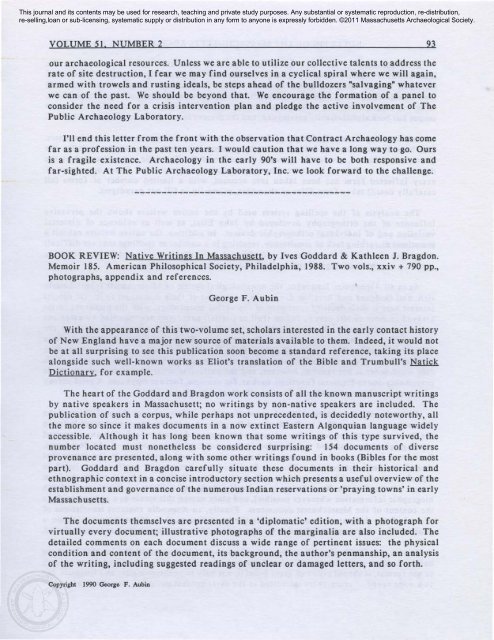No. 2 – October 1990
No. 2 – October 1990
No. 2 – October 1990
Create successful ePaper yourself
Turn your PDF publications into a flip-book with our unique Google optimized e-Paper software.
This journal and its contents may be used for research, teaching and private study purposes. Any substantial or systematic reproduction, re-distribution,<br />
re-selling,loan or sub-licensing, systematic supply or distribution in any form to anyone is expressly forbidden. ©2011 Massachusetts Archaeological Society.<br />
VOLUME 51. NUMBER 2 93<br />
our archaeological resources. Unless we are able to utilize our collective talents to address the<br />
rate of site destruction, I fear we may find ourselves in a cyclical spiral where we will again,<br />
armed with trowels and rusting ideals, be steps ahead of the bulldozers "salvaging" whatever<br />
we can of the past. We should be beyond that. We encourage the formation of a panel to<br />
consider the need for a crisis intervention plan and pledge the active involvement of The<br />
Public Archaeology Laboratory.<br />
I'll end this letter from the front with the observation that Contract Archaeology has come<br />
far as a profession in the past ten years. I would caution that we have a long way to go. Ours<br />
is a fragile existence. Archaeology in the early 90's will have to be both responsive and<br />
far-sighted. At The Public Archaeology Laboratory, Inc. we look forward to the challenge.<br />
BOOK REVIEW: Native Writings In Massachusett, by Ives Goddard & Kathleen J. Bragdon.<br />
Memoir 185. American Philosophical Society, Philadelphia, 1988. Two vols., xxiv + 790 pp.,<br />
photographs, appendix and references.<br />
George F. Aubin<br />
With the appearance of this two-volume set, scholars interested in the early contact history<br />
of New England have a major new source of materials available to them. Indeed, it would not<br />
be at all surprising to see this publication soon become a standard reference, taking its place<br />
alongside such well-known works as Eliot's translation of the Bible and Trumbull's Natick<br />
Dictionary, for example.<br />
The heart of the Goddard and Bragdon work consists of all the known manuscript writings<br />
by native speakers in Massachusett; no writings by non-native speakers are included. The<br />
publication of such a corpus, while perhaps not unprecedented, is decidedly noteworthy, all<br />
the more so since it makes documents in a now extinct Eastern Algonquian language widely<br />
accessible. Although it has long been known that some writings of this type survived, the<br />
number located must nonetheless be considered surprising: 154 documents of diverse<br />
provenance are presented, along with some other writings found in books (Bibles for the most<br />
part). Goddard and Bragdon carefully situate these documents in their historical and<br />
ethnographic context in a concise introductory section which presents a useful overview of the<br />
establishment and governance of the numerous Indian reservations or 'praying towns' in early<br />
Massachusetts.<br />
The documents themselves are presented in a 'diplomatic' edition, with a photograph for<br />
virtually every document; illustrative photographs of the marginalia are also included. The<br />
detailed comments on each document discuss a wide range of pertinent issues: the physical<br />
condition and content of the document, its background, the author's penmanship, an analysis<br />
of the writing, including suggested readings of unclear or damaged letters, and so forth.<br />
Copyright <strong>1990</strong> George F. Aubin
















